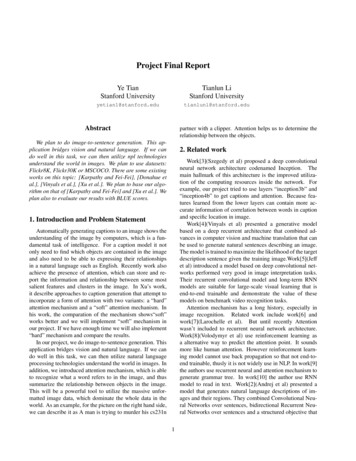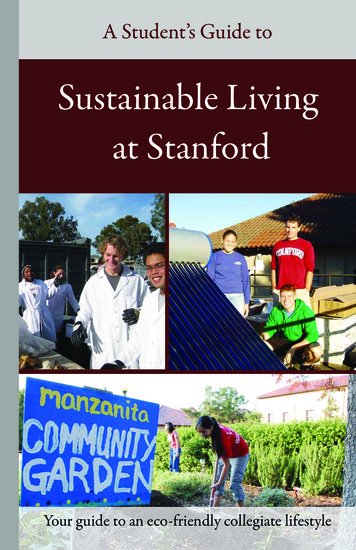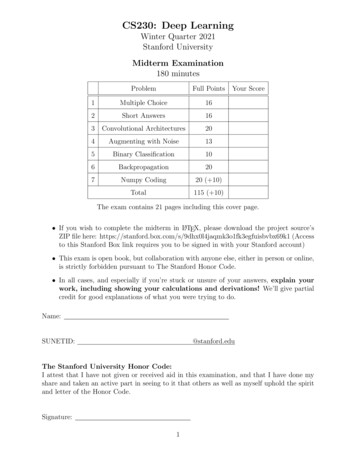
Transcription
Project Final ReportYe TianStanford UniversityTianlun LiStanford uAbstractpartner with a clipper. Attention helps us to determine therelationship between the objects.We plan to do image-to-sentence generation. This application bridges vision and natural language. If we cando well in this task, we can then utilize npl technologiesunderstand the world in images. We plan to use datasets:Flickr8K, Flickr30K or MSCOCO. There are some existingworks on this topic: [Karpathy and Fei-Fei], [Donahue etal.], [Vinyals et al.], [Xu et al.]. We plan to base our algorithm on that of [Karpathy and Fei-Fei] and [Xu et al.]. Weplan also to evaluate our results with BLUE scores.2. Related workWork[3](Szegedy et al) proposed a deep convolutionalneural network architecture codenamed Inception. Themain hallmark of this architecture is the improved utilization of the computing resources inside the network. Forexample, our project tried to use layers “inception3b” and“inception4b” to get captions and attention. Because features learned from the lower layers can contain more accurate information of correlation between words in captionand specific location in image.Work[4](Vinyals et al) presented a generative modelbased on a deep recurrent architecture that combined advances in computer vision and machine translation that canbe used to generate natural sentences describing an image.The model is trained to maximize the likelihood of the targetdescription sentence given the training image.Work[5](Jeffet al) introduced a model based on deep convolutional networks performed very good in image interpretation tasks.Their recurrent convolutional model and long-term RNNmodels are suitable for large-scale visual learning that isend-to-end trainable and demonstrate the value of thesemodels on benchmark video recognition tasks.Attention mechanism has a long history, especially inimage recognition. Related work include work[6] andwork[7](Larochelle et al). But until recently Attentionwasn’t included to recurrent neural network architecture.Work[8](Volodymyr et al) use reinforcement learning asa alternative way to predict the attention point. It soundsmore like human attention. However reinforcement learning model cannot use back propagation so that not end-toend trainable, thusly it is not widely use in NLP. In work[9]the authors use recurrent neural and attention mechanism togenerate grammar tree. In work[10] the author use RNNmodel to read in text. Work[2](Andrej et al) presented amodel that generates natural language descriptions of images and their regions. They combined Convolutional Neural Networks over sentences, bidirectional Recurrent Neural Networks over sentences and a structured objective that1. Introduction and Problem StatementAutomatically generating captions to an image shows theunderstanding of the image by computers, which is a fundamental task of intelligence. For a caption model it notonly need to find which objects are contained in the imageand also need to be able to expressing their relationshipsin a natural language such as English. Recently work alsoachieve the presence of attention, which can store and report the information and relationship between some mostsalient features and clusters in the image. In Xu’s work,it describe approaches to caption generation that attempt toincorporate a form of attention with two variants: a “hard”attention mechanism and a “soft” attention mechanism. Inhis work, the comparation of the mechanism shows“soft”works better and we will implement “soft” mechanism inour project. If we have enough time we will also implement“hard” mechanism and compare the results.In our project, we do image-to-sentence generation. Thisapplication bridges vision and natural language. If we cando well in this task, we can then utilize natural languageprocessing technologies understand the world in images. Inaddition, we introduced attention mechanism, which is ableto recognize what a word refers to in the image, and thussummarize the relationship between objects in the image.This will be a powerful tool to utilize the massive unformatted image data, which dominate the whole data in theworld. As an example, for the picture on the right hand side,we can describe it as A man is trying to murder his cs231n1
aligns the two modalities through a multimodal embedding.In Work[1](Xu, et al) attention mechanism is used in generation of image caption. They use convolutional neural network to encode image and use a recurrent neural networkand attention mechanism to generate caption. By the visualization of the attention weights, we can explain which partthe model is focusing on while generating the caption. Thispaper is also what our project based on.visual information related to a particular input location.E Rm K is an embedding matrix. m and n is the embedding and LSTM dimensionality respectively. σ andare the logistic sigmoid activation and element-wise multiplication respectively.The model define a mechanism φ that computes zˆt fromannotation vectors ai , i 1, ., L corresponding to the features extracted at different image locations. And zˆt is a representation of the relevant part of the image input at timet4. For each location i, the mechanism generates a positive weight αi that can be interpreted as the relative importance to give to location i in blending the αi ’s together. Themodel compute the weight αi by attention model fatt forwhich the model use multilayer perceptron conditioned onthe previous state ht 1 .3. Image Caption Generation with AttentionMechanism3.1. extract featuresThe input of the model is a single raw image and the output is a caption y encoded as a sequence of 1-of-K encodedwords.y {y1 , ., yC }, yi RKWhere K is the size of the vocabulary and C is the length ofthe caption.To extract a set feature vectors which we refer to as annotation vectors, we use a convolutional neural network.a {a1 , ., aL }, ai Rht ottanh(ct )(5)zˆt φ(ai , αi ),(6)where φ is a function that returns a single vector given theset of annotation vectors and their corresponding weights.he initial memory state and hidden state of the LSTMare predicted by an average of the annotation vectors fedthrough two separate MLPs.1co finit,c ( ΣLai )L i1ho finit,h ( ΣLai )L iThe model use a long short-term memory (LSTM) network that produces a cation. At every time step , we willgenerate one word conditioned on a context vector, the previous hidden state and the previously generated words.Using Ts,t : Rs Rt to denote a simple affine transformation with parameters that are learned.(work[1]) 1σEyt 1 2 σ ht 1 (1) 3 σ TD m n,nẑt4tanhgtexp(eti )exp etkΣLk 1After the weights are computed, the model then computethe context vextor zˆt byD3.2. caption generatorct 1 it(4)αti The extractor produces L vectors and each element corresponds to a part of the image as a D-dimensional representation.In the work[1], the feature vectors was extract from theconvolutional layer before the fully connected layer. Wewill try different layers such such as convolutional layers tocompare the result and try to choose the best layers to produce feature vectors that contains most precise in formationabout relationship between salient features and clusters inthe image.ct fteti fatt (ai , ht 1 )In the model, we will use a deep output layer to compute theoutput word probability given the LSTM state, the contextvector and the previous word:p(yt a, y1t 1 ) exp(Lo (Eyt 1 Lh ht Lz ẑt ))(7)Where Lo RK m , Lh Rm n , Lz Rm D ,and E arelearned parameters initialized randomly.3.3. Loss FunctionWe use a word-wise cross entropy as the basic loss function l0 . Further more, to encourage the attention function to produce more expressive output, we define l1 , l2 asthe variace of αt along the sepence axis and spacial axisecorrespondingly. Then define the overall loss function asl l0 λ1 l1 λ2 l2 , where λ1 and λ2 are hyperparameters.(2)(3)Where, respectively it , ft , ct , ot , ht are the input, forget,memory, output and hidden state of the LSTM. The vector ẑ RD represents the context vector, capturing the2
4. ArchitectureCNN features have the potential to describe the image. To leverage this potential to natural language, ausual method is to extract sequential information and convert them into language. In most recent image captioningworks, they extract feature map from top layers of CNN,pass them to some form of RNN and then use a softmax toget the score of the words at every step. Now our goal is, inaddition to captioning, also recognize the objects in the image to which every word refers to. In other word, we wantposition information. Thus we need to extract feature froma lower level of CNN, encode them into a vector which isdominated by the feature vector corresponding to the objectthe word wants to describe, and pass them into RNN. Motivated by the work asdasdasdasd, we design the architecturesbelow.{ai } is the feature vector from CNN. We get these feature map from the inception-5b layer of google net, whichmeans we have 6x6 feature vectors with 1024 dimensions.Firstly, we use function finit , h and finit , c to generate initial hidden state and cell state for the LSTMs. Input ofLSTM0 is word embeddings. Input of LSTM1 is h0, whichis the output of LSTM0, concatenated with attention vectorz, which is an weighted average over {ai }. The weight alpha is computed from the combination of h0, representinginformation of current word, and each of {ai }, representingposition information.Our labels are only captions of the images. But to geta better caption, the network must force alpha to extract asmuch information as possible from {ai } at each step, whichmeans alpha should put more weights on the area of the nextword. This alpha is exactly the attention we want. Here forfinit , h, finit , c, we use multilayer perceptrons(MLP). Forfatt , we use a CNN with 1x1 filters.To further reduce the influence of the image informationas a whole and thus put more weight on attention information, we build a new model where we send {ai } directly tothe first input of LSTM0 throug a MLP, and initialize h andc as 0. An even more extreme model is to only use z asinformation source from the 1h00(1)finit,c1 aiL(1)finit,h{ai }c10h10LSTM0LSTM0Ey1 fattEy0 fatt{ i0 }{a1i }z1z0h10h11LSTM1LSTM1h01h00LSTM0LSTM0{ai }1 aiLMLPEy0 fattfatt{ i0 }{a1i }z1z0h10h11LSTM1LSTM1h01h00LSTM0LSTM0{ai }Ey1 fattEy0 fatt{ i0 }{a1i }z0z1Figure 1: The first is original model. The second is Modelwith more weights on attention. The third is Model onlydepending on attention5. Dataset and FeaturesWe use dataset from MSCOCO. A picture is representedby a dictionary, the keys are as follow: [sentids, filepath,filename, imgid, split, sentences, cocoid]. Where the sentences contain five sentences related to the picture. We have82783 training data and 40504 validation data to train andtest out model.For the sentences, we build a word-index mapping, adda “#START#” and “#END#” symbol to its both ends, andadd “#NULL#” symbol to make them the same length. Because some words in the sentences are very sparse, whenwe generate a vocabulary from the sentences we need toset a threshold to decrease the classification error. Thethreshold should not only remove the spares words, but alsoavoid producing too many unknown words when predictthe sentences. Thus, we observe the curve of vocabularysize – threshold and the total word size – threshold, whichare showed in Fig 2. The previous one is exponential and3
we used a large minibatch size of 512 samples.At the beginning, we can overfit a small dataset with1000 samples. But when we went to full dataset of 120,000samples, we cannot overfit it even we increase the number of hidden units and depth of attention function. Thenwe adopted a gradually tuning method: train the model ondataset with size of 1000, 10000, 60000 and gradually pickour hyperparameters. Finally we got a good model with60000 training samples, LSTM hidden size of 512 and MLPhidden size for [1024, 512, 512, 512], which generalize decently 00001220000010203040506.2. Results14000Some of our results are shown in Fig 4 and Fig 5.We can see that the generated sentences expressed thepictures quite well. The main parts of the images can berecognized and shown in the sentence, and also of the minor parts are also encoded, such as the flower in the cornerof xxxxxxxxx. Also, there are some mistakes such as the refrigerator and lamp in xxxxxxxxxx. But we human beingsare also easy to make such mistakes since there do existsimilar objects in the image. The generated sentences alsodo well in following grammar.As for attention, our model is only able to recognize themost important part of the images. That is, the attentions ateach step are the same. There are 2 major reasons. Firstly,since the features are input at the first step of LSTM, theoverall information of the image has been feed into the decoder, which is enough to generate a decent sentence, andthus the following inputs can be coarser. This is exactlythe motivation of our other models. They are potential towork better given more finetune. Secondly, the receptivefield of inception 5 is quite large (139 x 139). So to focuson the main part of image is enough to get a good sentence.To address this problem, we can use lower level featuresfrom CNN with more expressive fatt , i.e., to deepen thefatt CNN and enlarge the number of hidden units in eachlayer.We used BLEU score as quantitative metric for our results. We can see our model cannot achieve the state-ofthe-art. To get better results, we should enlarge our model,train and tune it re 2: the upper figure is vocabulary size – thresholdcurve, the lower figure is total word count – threshold curvethe latter one is linear, so we choose 10 as our threshold.For images, we preprocessing them by cropping them to224x224 and subtract the mean. Because they are already alarge number of data, we dont do any data augmentations.We tried to extract features of “inception3b”, “inception4b” and “inception5b” from Googlenet. Among them,“inception5b” is relative higher than the previous 2 layers,thusly it contains less region information and hard to betrained to get attention. The layer “inception3b” is relativelower so that it contains more region information but lessexpressive to for caption.6. Experiment, Result and DiscussionModelBRNN(work[2])Google NICLog [1])Our-model6.1. ExperimentIn our architecture there are 2 parts. One is CNN encoderto map image to features, and the other is LSTM decoderwith attention functions, which is a small CNN with 1x1filters. We didnt finetune the encoder part and only trainedthe decoder part. To train the decoder, we used adam update. We tried learning rate from 1 to 1e-5 and found 5e-4with decay rate 0.995 produce a best learning curve. Because feaure maps are smaller than images, and only decoder part was trained, so to make best of GPU 4.324.325.014.8Table 1: BLEU-1,2,3,4 metrics compared to other methods4
(a) a black bear with (b) a woman stand- (c) a meal sitting inflowers resting on a ing on top of a court top of a table on abedwith a tennis racquet wooden tableFigure 4: Training Set(a) a man are sit- (b) a kitchen is filled (c) a woman standting at a kitchen area with a lamp and re- ing on front of awith a group inside frigeratorphone and head to ahouseFigure 5: Validation Seta horse, the loss will be small, but this is actually a wrongdescription of the picture.Sharper attention: From the result we notice that the attention coefficient are evenly distributed, which means thatthe model takes the whole picture information to generatethe next time step hidden layer via LSTM. But we expectthat we can highlight specific part of the picture related tothe certain word. To achieve this goal we can use hard attention, which restricts information extraction from imageas whole. We can also use a harper activation function instead of softmax to produce a suitable attention distribution.Moreover, we can label more detailed captions to force themode to attend smaller parts.Language model: Since the model will produce a probability distribution of the vocabulary on every time step, wecan use language model to generate natural sentences basedon these vocabulary probability distributions. Further more,we can build a markov random field like hidden markovmodel on the top of the the softmax output layer.We can try different architecture and especially layer ofCNN encoder to get a better feature map level.Figure 3: 5 most probable words generated by the modelwith one input image7. Furture WorkAdvanced loss function: The original softmax loss function can cause problems. It can produce force negative. Forexample, if we input a the test picture with caption A manis riding a horse, the produced caption A horse is carryinga horse will produce high loss, but actually these two caption all correctly describe the picture. On the other hand themodel can also produce force negative. For example, if theprevious test picture produces a caption A man is carryingReferences[1] Xu, Kelvin, Jimmy Ba, Ryan Kiros, Aaron Courville,Ruslan Salakhutdinov, Richard Zemel, and YoshuaBengio.“Show, attend and tell: Neural image cap5
tion generation with visual attention.” arXiv preprintarXiv:1502.03044(2015).[2] Karpathy, Andrej, and Li Fei-Fei. “Deep visualsemantic alignments for generating image descriptions”In Proceedings of the IEEE Conference on Computer Vision and Pattern Recognition, pp. 3128-3137. 2015.[3] Szegedy C, Liu W, Jia Y, et al. Going deeper with convolutions[C]//Proceedings of the IEEE Conference onComputer Vision and Pattern Recognition. 2015: 1-9.[4] Vinyals, Oriol, Alexander Toshev, Samy Bengio, andDumitru Erhan. “Show and tell: A neural image caption generator.” In Proceedings of the IEEE Conferenceon Computer Vision and Pattern Recognition, pp. 31563164. 2015.[5] Donahue, Jeffrey, Lisa Anne Hendricks, SergioGuadarrama, Marcus Rohrbach, Subhashini Venugopalan, Kate Saenko, and Trevor Darrell. “Long-termrecurrent convolutional networks for visual recognitionand description.” In Proceedings of the IEEE Conferenceon Computer Vision and Pattern Recognition, pp. 26252634. 2015.[6] Larochelle H, Hinton G E. Learning to combinefoveal glimpses with a third-order Boltzmann machine[C]//Advances in neural information processingsystems. 2010: 1243-1251.[7] Denil M, Bazzani L, Larochelle H, et al. Learningwhere to attend with deep architectures for image tracking[J]. Neural computation, 2012, 24(8): 2151-2184.[8] Mnih V, Heess N, Graves A. Recurrent models of visual attention[C]//Advances in Neural Information Processing Systems. 2014: 2204-2212.[9] Vinyals O, Kaiser , Koo T, et al. Grammar as a foreignlanguage[C]//Advances in Neural Information Processing Systems. 2015: 2755-2763.[10] Hermann K M, Kocisky T, Grefenstette E, et al. Teaching machines to read and comprehend[C]//Advances inNeural Information Processing Systems. 2015: 16841692.6
Project Final Report Ye Tian Stanford University yetian1@stanford.edu Tianlun Li Stanford University tianlunl@stanford.edu Abstract We plan to do image-to-sentence generation. This ap-plication bridges vision and natural language. If we can do well in this task, we can then utilize npl techno










